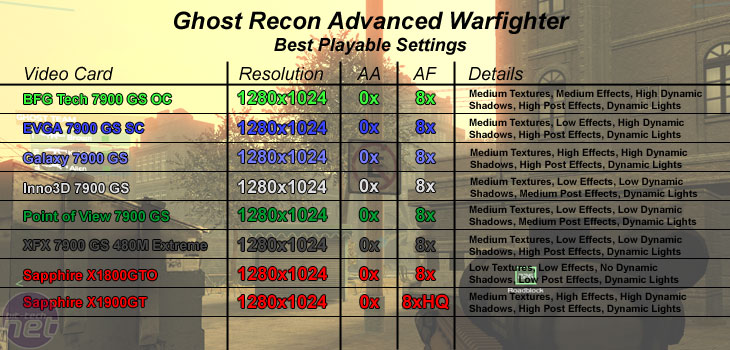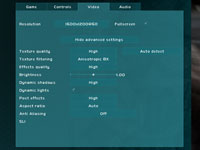GeForce 7900 GS Group Test
September 21, 2006 | 11:03

Ghost Recon Advanced Warfighter:
Publisher: UbisoftWe used the latest addition to Tom Clancy's Ghost Recon series - Ghost Recon Advanced Warfighter and patched the game to version 1.21. This has to be one of the best-looking games on the market at the moment, even despite its lack of support for anti-aliasing on any of today's current hardware. The game makes use of High Dynamic Range lighting and a whole plethora of special effects. Probably the biggest talking point for Ghost Recon Advanced Warfighter is its support for AGEIA's PhysX PPU.
The lack of support for anti-aliasing may seem like a backwards step in image quality, as there are many areas of the game that could certainly benefit from a multisample anti-aliasing pattern. The lack of anti-aliasing support is due to the fact that the game uses multiple render targets to achieve some of the advanced graphical effects. This is due to the way that the DirectX 9.0 specification was set out, and even if multiple render targets and anti-aliasing could work in harmony, it'd be incredibly costly because every surface in the multiple render target would need to be sampled.
We did a five minute manual run through from the start of the Strong Point level. This incorporates lots of post processing effects, HDR lighting, explosions, gun fire and water, too in order to give the graphics subsystem a good work out. The game has no support for anti-aliasing, but anisotropic filtering was controlled from inside the game.


The difference in memory clocks between the BFG Tech and Galaxy cards meant that we had to lower the effects quality to medium on BFG Tech's card, while everything else remained the same. Sapphire's Radeon X1900GT delivered the same kind of performance as the Galaxy 7900 GS, but with a slightly lower frame rate. However, the textures were much sharper in the distance, thanks to ATI's high quality anisotropic filtering mode.
EVGA's lower clocks meant that we had to lower effects quality down to the lowest setting in order to keep an acceptable frame rate. With effects quality set to medium, we had some moments where the game was very choppy and unplayable. The further core clock deficit on XFX's 480M Extreme card meant that we had to lower dynamic shadows to low, too, while post effects quality remained at the highest setting.
Both the Point Of View and Inno3D 7900 GS cards delivered an optimal gaming experience with low effects, low dynamic shadows and medium post effects quality. The Radeon X1800GTO delivered the worst gaming experience of the bunch, with everything set to the minimum setting, except for dynamic lights, which were left enabled. The gameplay wasn't quite what we'd call super smooth, but it was adequate.

MSI MPG Velox 100R Chassis Review
October 14 2021 | 15:04








Want to comment? Please log in.